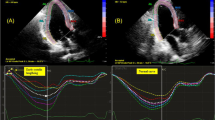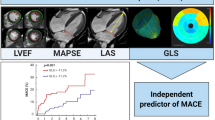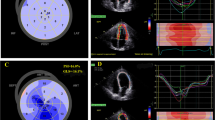Abstract
Background
Although there is reportedly a usefulness of left ventricular global longitudinal strain (LV GLS) on 2D speckle-tracking echocardiography in excluding significant coronary artery disease (CAD) in suspected intermediate- or low-risk non-ST-segment elevation–acute coronary syndrome (NSTE–ACS), the efficacy of post-systolic index (PSI) in this context is yet unknown. Therefore, we explored the usefulness of PSI in facilitating stratification of risk in patients with intermediate- or low-risk NSTE–ACS.
Methods and results
We assessed 50 consecutive patients suspected of intermediate- or low-risk NSTE–ACS, and finally analyzed 43 patients whose echocardiographic images were suitable for strain analysis. All patients underwent CAG. Among the 43 analyzed patients, 26 had CAD, and 21 underwent percutaneous coronary intervention (PCI). Patients with CAD had higher PSI (25% [20.8–40.3%] vs 15% [8.0–27.5%], P = 0.007). Receiver–operator characteristic curve analysis identified that a PSI of > 20% detected performance of PCI (sensitivity 80.7%, specificity 70.6%, area under curve [AUC] 0.72, 95% confidence interval [CI] 0.57–0.88). Moreover, the AUC obtained using the GRACE risk score was 0.57 (95% CI 0.39–0.75), and increased to 0.75 (95% CI 0.60–0.90) when PSI and LV GLS were added. Thus, the addition of PSI and LV GLS improved the classification of performance of PCI (net reclassification improvement [95%CI] 0.09 [0.0024–0.18], P = 0.04).
Conclusions
Post-systolic index is a useful parameter that can facilitate stratification of risk in patients with intermediate- or low-risk NSTE–ACS. We recommend measuring PSI in routine clinical practice.



Similar content being viewed by others
Data availability
The authors declare that no funds, grants, or other support were received during the preparation of this manuscript.
References
Granger CB, Goldberg RJ, Dabbous O, et al. Predictors of hospital mortality in the global registry of acute coronary events. Arch Intern Med. 2003;163:2345–53.
Amsterdam EA, Wenger NK, Brindis RG, et al. 2014 AHA/ACC guideline for the management of patients with non-ST-elevation acute coronary syndromes: a report of the American College of Cardiology/American Heart Association Task Force on Practice Guidelines. J Am Coll Cardiol. 2014;64(24):e139-228.
Roffi M, Patrono C, Collet JP, et al. 2015 ESC guidelines for the management of acute coronary syndromes in patients presenting without persistent ST-segment elevation: Task force for the management of acute coronary syndromes in patients presenting without persistent ST-segment elevation of the European society of cardiology (ESC). Eur Heart J. 2016;37(3):267–315.
Sjøli B, Ørn S, Grenne B, Ihelen H, Edvardsen T, Brunvand H. Diagnostic capability and reproducibility of strain by doppler and by speckle tracking in patients with acute myocardial infarction. JACC Cardiovasc Imaging. 2009;2(1):24–33.
Choi JO, Cho SW, Song YB, et al. Longitudinal 2D strain at rest predicts the presence of left main and three vessel coronary artery disease in patients without regional wall motion abnormality. Eur J Echocardiogr. 2009;10:695–701.
Winter R, Jussila R, Nowak J, et al. Speckle tracking echocardiography is a sensitive tool for the detection of myocardial ischemia: a pilot study from the catheterization laboratory during percutaneous coronary intervention. J Am Soc Echocardiogr. 2007;20:974–81.
Dahlslett T, Karlsen S, Grenne B, et al. Early assessment of strain echocardiography can accurately exclude significant coronary artery stenosis in suspected non-ST-segment elevation acute coronary syndrome. J Am Soc Echocardiogr. 2014;27:512–9.
Marques-Alves P, Espírito-Santo N, Baptista R, et al. Two-dimensional speckle-tracking global longitudinal strain in high-sensitivity troponin-negative low-risk patients with unstable angina: a “resting ischemia test”? Int J Cardiovasc Imaging. 2018;34(4):561–8.
Brainin P, Biering-Sørensen SR, Møgelvang R, Søgaard P, Jensen JS, Biering-Sørensen T. Postsystolic shortening by speckle tracking echocardiography is an independent predictor of cardiovascular events and mortality in the general population. J Am Heart Assoc. 2018;7: e008367.
Kukulski T, Jamal F, Herbots L, et al. Identification of acutely ischemic myocardium using ultrasonic strain measurements: a clinical study in patients undergoing coronary angioplasty. J Am Coll Cardiol. 2003;41:810–9.
Rambaldi R, Bax JJ, Rizzello V, et al. Post-systolic shortening during dobutamine stress echocardiography predicts cardiac survival in patients with severe left ventricular dysfunction. Coron Artery Dis. 2005;16:141–5.
Asanuma T, Fukuta Y, Masuda K, Hioki A, Iwasaki M, Nakatani S. Assessment of myocardial ischemic memory using speckle tracking echocardiography. JACC Cardiovasc Imaging. 2012;5:1–11.
Lang RM, Badano LP, Mor-Avi V, et al. Recommendations for cardiac chamber quantification by echocardiography in adults: an update from the American Society of Echocardiography and the European Association of Cardiovascular Imaging. J Am Soc Echocardiogr. 2015;16:233–70.
Haugaa KH, Goebel B, Dahlslett T, et al. Risk assessment of ventricular arrhythmias in patients with nonischemic dilated cardiomyopathy by strain echocardiography. J Am Soc Echocardiogr. 2012;25:667–73.
Senni M, Tribouilloy CM, Rodeheffer RJ, et al. Congestive heart failure in the community: a study of all incident cases in Olmsted County, Minnesota, in 1991. Circulation. 1998;98:2282–9.
Asanuma T, Uranic A, Masuda K, Ishikura F, Beppu S, Nakatani S. Assessment of myocardial ischemic memory using persistence of post-systolic thickening after recovery from ischemia. JACC Cardiovasc Imaging. 2009;2(11):1253–61.
Voigt JU, Lindenmeier G, Exner B, et al. Incidence and characteristics of segmental postsystolic longitudinal shortening in normal, acutely ischemic, and scarred myocardium. J Am Soc Echocardiogr. 2003;16:415–23.
Smiseth OA, Torp H, Opdahl A, Haugaa KH, Urheim S. Myocardial strain imaging: how useful is it in clinical decision making? Eur Heart J. 2016;37(15):1196–207.
Nucifora G, Schuijf JD, Delgado V, et al. Incremental value of subclinical left ventricular systolic dysfunction for the identification of patients with obstructive coronary artery disease. Am Heart J. 2010;159(1):148–57.
Biering-Sørensen T, Hoffmann S, Mogelvang R, et al. Myocardial strain analysis by 2-dimensional speckle tracking echocardiography improves diagnostics of coronary artery stenosis in stable angina pectoris. Circ Cardiovasc Imaging. 2014;7(1):58–65.
Liang H-Y, Cauduro S, Pellikka P, et al. Usefulness of two-dimensional speckle strain for evaluation of left ventricular diastolic deformation in patients with coronary artery disease. Am J Cardiol. 2006;98(12):1581–6.
Funding
None.
Author information
Authors and Affiliations
Corresponding author
Additional information
Publisher's Note
Springer Nature remains neutral with regard to jurisdictional claims in published maps and institutional affiliations.
Rights and permissions
Springer Nature or its licensor (e.g. a society or other partner) holds exclusive rights to this article under a publishing agreement with the author(s) or other rightsholder(s); author self-archiving of the accepted manuscript version of this article is solely governed by the terms of such publishing agreement and applicable law.
About this article
Cite this article
Masada, K., Hidaka, T., Urabe, Y. et al. Usefulness of post-systolic index in facilitating stratification of risk in patients with intermediate- or low-risk non-ST-segment elevation acute coronary syndrome. J Echocardiogr 21, 157–164 (2023). https://doi.org/10.1007/s12574-023-00612-0
Received:
Revised:
Accepted:
Published:
Issue Date:
DOI: https://doi.org/10.1007/s12574-023-00612-0




